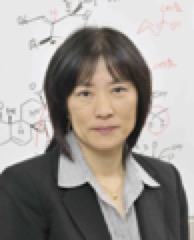Org. Synth. 2021, 98, 84-96
DOI: 10.15227/orgsyn.098.0084
Cu-catalyzed Allylic Perfluoroalkylation of Alkenes Using Perfluoro Acid Anhydrides: Preparation of N-(5,5,5-Trifluoro-2-penten-1-yl)phthalimide
Submitted by Yuma Aoki, Shintaro Kawamura, and Mikiko Sodeoka
1*
Checked by Martina Drescher, Daniel Kaiser, and Nuno Maulide
1. Procedure (Note 1)
(Caution!) There is a possibility of explosions when handling bis(trifluoroacetyl)peroxide (BTFAP) generated as a reactive intermediate in the present reaction. In particular, the phase transition from the liquid to the solid state must be avoided in accordance with the literature.2 The peroxide must be carefully quenched with sat. K2CO3 aqueous as described in the procedure, and the peroxide content in the organic phase after the extraction must be checked with a test paper as described in the procedure before evaporation of the organic solvent.
N-(5,5,5-Trifluoro-2-penten-1-yl)phthalimide (2). A stirring bar (7 x 50 mm) is placed in a three-necked round-bottomed flask (500-mL size) (
Note 2). The flask is fitted with two glass stoppers and a reflux condenser is connected to a vacuum-argon manifold with a KOH trap in-between (Figure 1). After addition of
urea·H2O2 (4.85 g, 51.6 mmol, 1.2 equiv) (
Note 3) to the flask, it is evacuated and backfilled with argon gas (>99.999%) three times and purged with the gas very slowly during the reaction. Then,
CH2Cl2 (100 mL) (
Note 3) is added from a 100-mL syringe fitted with PFA tubing (
Note 2), after replacing the two glass stoppers with a rubber septum and an internal thermometer equipped with a Teflon
® adapter. The slurry is cooled with an ice-salt bath and is slowly stirred (150 rpm) (
Note 4) until the temperature falls to 2±1 °C (for ca. 1 h).
Figure 1. Reaction set-up (photo provided by submitters)
After cooling,
trifluoroacetic anhydride (59.8 mL, 430 mmol, 10 equiv) (
Note 3) is added to the mixture from a syringe fitted with PFA tubing (100-mL size) over ca. 5 min, temporarily leading to an increase of the internal temperature of 5 °C. The rubber septum is replaced with a glass cap, and the mixture is stirred at 2±1 °C for 1 h (Figure 2a). Then,
N-(3-buten-1-yl)phthalimide 1 (8.65 g, 43 mmol, 1.0 equiv) (
Note 3) is added in one portion
via a funnel, followed by the addition of
[Cu(CH3CN)4]PF6 (3.21 g, 8.6 mmol, 20 mol %) (
Note 3) in one portion. After the addition of the copper catalyst, the reaction mixture is warmed to 40 °C. The color of the solution changes from colorless to aqua blue, and small bubbles of carbon dioxide appear (Figure 2b) (
Note 5). The mixture is stirred for 4 h and completion of the reaction is confirmed by TLC analysis (Figure 3a) (
Note 6).
Figure 2. (a) Reaction of urea·H2O2 with trifluoroacetic anhydride (b) Color change after addition of Cu catalyst (photos provided by submitters)
The mixture is cooled to 2±1 °C and diluted with
CH2Cl2 (200 mL) and transferred to a 1 L round-bottomed flask. While further cooling, sat.
K2CO3 aqueous solution (300 mL) is added while monitoring the appearance of bubbles due to neutralization. Initially, this addition is performed drop wise, using a Pasteur pipette. After ~50 mL have been added in this manner, the remaining solution is slowly poured into the vigorously stirred mixture over the course of 2 min. The mixture is further stirred at ambient temperature (22-25 °C) for 1 h and transferred to a separatory funnel (1-L size). The aqueous layer is extracted with
CH2Cl2 (3 x 200 mL), allowing the mixture to stand for 10 min each time to ensure adequate separation of the phases. The organic phases are combined in an Erlenmeyer flask (2-L size). The combined organic phase is washed with brine (50 mL) and dried over 50 g of anhydrous
Na2SO4. The absence of peroxides in the organic phase is confirmed by using a peroxide detection strip (Figure 3b) (Notes
7 and
8). The organic phase is filtered into a flask (2-L size) through a sintered glass filter (100-mL size), and the filtrate is evaporated in a rotary evaporator (80 mmHg, 30 °C). The obtained crude product (12.4 g) is purified by means of chromatography on silica (
Note 9). The product, containing a small amount of impurities, is obtained as a white solid (8.08 g) after concentration of the combined fractions by removal of the solvent with a rotary evaporator (80 mmHg, 30 °C) and drying in vacuo (<6 mmHg) for 3 h.
Figure 3. (a) TLC analysis of the reaction mixture (rxn) after 4 h (b) Detection of peroxide content in organic and aqueous phases after extraction (photos provided by submitters)
Heptane (15 mL) is added to the white solid in a 50 mL round-bottomed flask, and the white solid is roughly crushed with a spatula into pieces smaller than ca. 0.5 cm (Figure 4). The liquid phase is decanted with the aid of a glass Pasteur pipette (ca. 1.5 mL, 9-inch size; Iwaki IK-PAS-9P). The resulting white solid is further purified by repeating the crush-decantation process three more times, and then drying the residue in vacuo (<6 mmHg) for 3 h to give product
2 (5.66 g, 49% yield, 97% purity,
E/Z = 88.5/11.5) (Notes
10,
11,
12, and
13) (Figure 5), which can be stored under ambient conditions.
Figure 4. Crushing lumps of the white solid with a spatula (photo provided by submitters)
Figure 5. Photograph of pure product 2 (photo provided by submitters)
2. Notes
1. Prior to performing each reaction, a thorough hazard analysis and risk assessment should be carried out with regard to each chemical substance and experimental operation on the scale planned and in the context of the laboratory where the procedures will be carried out. Guidelines for carrying out risk assessments and for analyzing the hazards associated with chemicals can be found in references such as Chapter 4 of "Prudent Practices in the Laboratory" (The National Academies Press, Washington, D.C., 2011; the full text can be accessed free of charge at
https://www.nap.edu/catalog/12654/prudent-practices-in-the-laboratory-handling-and-management-of-chemical. See also "Identifying and Evaluating Hazards in Research Laboratories" (American Chemical Society, 2015) which is available via the associated website "Hazard Assessment in Research Laboratories" at
https://www.acs.org/content/acs/en/about/governance/committees/chemicalsafety/hazard-assessment.html. In the case of this procedure, the risk assessment should include (but not necessarily be limited to) an evaluation of the potential hazards associated with
urea hydrogen peroxide,
trifluoroacetic anhydride,
N-(3-buten-1-yl)phthalimide,
tetrakis(acetonitrile)copper(I) hexafluorophosphate,
dichloromethane,
potassium carbonate,
heptane, and
sodium sulfate.
2. All glassware used is dried in the oven before use. Very small amounts of grease or Teflon rings are used to seal glass joints and stopcocks. PTFE tape is used to fix and seal connections between the flask and each PVC tubing, septum, and thermometer. A syringe fitted with PFA tubing instead of a metal-needle is used to avoid the possibility of contamination of the peroxide solution with metals (see Figure 6). The vacuum/argon gas manifold system is equipped with a bubbler containing liquid paraffin at the inlet and outlet, as shown in Figure 7.
Figure 6. Syringe fitted with PFA tubing (photo provided by submitters)
Figure 7. Vacuum/nitrogen gas manifold system (photo provided by submitters)
3.
Urea·H2O2 (97%) was obtained from Aldrich Chemical Co., Inc. and used as received. Anhydrous
CH2Cl2 (<10 ppm of water and <1 ppm O
2 contents) was obtained from Kanto Chemical Co., Inc. and further purified by using a Glass Contour Solvent Filtration System equipped with columns of alumina and a supported copper catalyst prior to use. The checkers purchased
dichloromethane (99.6%) from Acros Organics and the solvent was used as received.
Trifluoroacetic anhydride (>98.0%),
N-(3-buten-1-yl)phthalimide (>98%), and
[Cu(CH3CN)4]PF6 (>97.0%) were obtained from Tokyo Chemical Industry Co., Ltd and used as received. The checkers purchased
[Cu(CH3CN)4]PF6 (>97.0%) from Sigma Aldrich and the chemical was used as received.
4. Particles of
urea·H2O2 are scattered and adhere to the surface of the flask if stirring is vigorous. Thus, gentle stirring (ca. 150 rpm) is necessary.
5. The checkers observed the transient formation of a light blue precipitate. Carbon dioxide (CO
2) gas is released through the argon line under a slight positive flow of nitrogen gas.
6. The reaction is monitored by TLC analysis on Merck silica-gel 60 F
254 plates with
CH2Cl2 as the eluent. Spots on the TLC plate are visualized with a UV lamp (254 nm). The R
f values of
1 and
2 are 0.54 and 0.57, respectively.
7. XploSens PS
TM was used to test for peroxides.
Bis(trifluoroacetyl)peroxide (
19F NMR signal at -70.8 ppm in CDCl
3) could not be detected in the organic and water phases by
19F NMR analysis. As shown in Figure 3, the test paper indicated no peroxide content in the organic phase. Thus, we can conclude that no other potentially hazardous species, such as trifluoroacetoxy peracid, is present. In addition,
19F NMR analysis of the water phase shows only the signal derived from trifluoroacetic acid, which suggests that the basic workup sufficiently hydrolyzes diacyl peroxide to afford hydrogen peroxide.
8. Peroxides in the water phase are quenched with sat.
Na2S2O3 aqueous solution.
9. Silica gel chromatography was performed using a column (5 x 30 cm) containing 170 g of silica eluted with
CH2Cl2 (3 L). Fraction sizes of approximately 95 mL were obtained using 100-mL test tubes. The product (R
f = 0.57) (Note 6) was found in fractions 6-15.
10. Characterization of
2: mp (mixture of
E- and
Z-isomers,
E/
Z = 91/9) 83-84 °C;
1H NMR
pdf (600 MHz, CDCl
3) δ:
E-isomer: 2.75-2.87 (m, 2H), 4.30 (d,
J = 5.9 Hz, 2H), 5.65- 5.69 (m, 1H), 5.81 (dt,
J = 15.3, 5.8 Hz, 1H), 7.69-7.76 (m, 2H), 7.82-7.89 (m, 2H);
Z-isomer: 3.10-3.22 (m, 2H), 4.30 (overlap, 2H), 5.60-5.74 (overlap, 1H), 5.81 (overlap, 1H), 7.69-7.76 (m, 2H), 7.82-7.89 (m, 2H);
13C NMR
pdf (151 MHz, CDCl
3) δ:
E-isomer: 37.1 (q,
J = 30 Hz), 39.2, 122.3 (q,
J = 3.9 Hz), 123.5 (2C), 125.7 (q,
J = 276 Hz), 131.0, 132.2 (2C), 134.2 (2C), 167.9 (2C);
Z-isomer: 32.5 (q,
J = 30 Hz), 34.5, 122.2 (q,
J = 3.9 Hz), 123.5 (2C), 126.1 (q,
J = 277 Hz), 129.4, 132.2 (2C), 134.2 (2C), 167.9 (2C);
19F NMR
pdf (565 MHz, CDCl
3): δ:
E-isomer: -66.29 (t,
J = 10.6 Hz),
Z-isomer: -65.97 (t,
J = 10.4 Hz). IR (neat, cm
-1) 2934, 1771, 1711, 1489, 1430, 1397, 1350, 1337, 1293, 1264, 1245, 1172, 1147, 1128, 1098, 1047, 942, 721, 712; HRMS (ESI+) calc. for C
13H
10F
3NO
2 [M+Na]
+ 292.0556, found 292.0550.
11. The purity was determined to be 97% by quantitative
1H NMR
pdf spectroscopy in CDCl
3 using 53.8 mg of the compound
2 together with 13.9 µL of
CH2Br2 as an internal standard.
12. A second run on half scale gave 2.79 g of an identical product (48%, 98% purity,
E/
Z = 89/11).
13. The submitters reported a yield of 41% (4.80 g, 99% purity,
E/
Z = 91/9) when using hexane in the crush-decantation process. Additional pure product
2 (2%, 0.21 g, 99% purity,
E/
Z = 85/15) was obtained by evaporation of the hexane washings followed by drying in vacuo (<6 mmHg) for 3 h. The total yield of
2 was 5.01 g (43%). The checkers obtained no additional product from the residual
heptane solutions.
Working with Hazardous Chemicals
The procedures in
Organic Syntheses are intended for use only by persons with proper training in experimental organic chemistry. All hazardous materials should be handled using the standard procedures for work with chemicals described in references such as "Prudent Practices in the Laboratory" (The National Academies Press, Washington, D.C., 2011; the full text can be accessed free of charge at
http://www.nap.edu/catalog.php?record_id=12654). All chemical waste should be disposed of in accordance with local regulations. For general guidelines for the management of chemical waste, see Chapter 8 of Prudent Practices.
In some articles in Organic Syntheses, chemical-specific hazards are highlighted in red "Caution Notes" within a procedure. It is important to recognize that the absence of a caution note does not imply that no significant hazards are associated with the chemicals involved in that procedure. Prior to performing a reaction, a thorough risk assessment should be carried out that includes a review of the potential hazards associated with each chemical and experimental operation on the scale that is planned for the procedure. Guidelines for carrying out a risk assessment and for analyzing the hazards associated with chemicals can be found in Chapter 4 of Prudent Practices.
The procedures described in Organic Syntheses are provided as published and are conducted at one's own risk. Organic Syntheses, Inc., its Editors, and its Board of Directors do not warrant or guarantee the safety of individuals using these procedures and hereby disclaim any liability for any injuries or damages claimed to have resulted from or related in any way to the procedures herein.
3. Discussion
Fluoroalkyl group-containing molecules are of interest as drug candidates, agrochemicals, and chemical probe molecules in chemical biology research, because the fluorine-containing group often improves pharmaceutical efficacy and can be used for bioisosteric replacement.
3 Therefore, a practical fluoroalkylation method employing user-friendly fluoroalkyl sources is highly desirable. Among various fluoroalkyl sources, fluorine containing acid anhydride should be suitable because it is low-cost, readily available, and applicable for a range of organic syntheses.
4,5,6,7,8,9 In this context, we developed allylic fluoroalkylations of simple alkenes by using the acid anhydrides as fluoroalkyl sources (Scheme 1).
7,8 Specifically, diacyl peroxide is generated
in situ from acid anhydride and urea-hydrogen peroxide and used as a reagent for allylic fluoroalkylation reaction of alkenes. The key to success is to control the selectivity with the aid of a copper catalyst, because a complex mixture is obtained in its absence. For perfluoroalkylation (R
f = CF
3, C
2F
5, and C
3F
7), [Cu(CH
3CN)]
4PF
6 is the optimal catalyst, affording the desired product in up to 95% yield (Scheme 1a).
7 The combination of Cu(O
2CCF
3)
2 as the catalyst and pyridine as an additive enables efficient allylic chlorodifluromethylation using chlorodifluoroacetic anhydride (Scheme 1b).
8
Scheme 1. Cu-catalyzed allylic fluoroalkylations using acid anhydrides
Notably, as an exceptional case of successful fluoroalkylation of simple alkenes using acid anhydrides in the absence of a Cu catalyst, an alkene bearing a pendant aromatic ring
5 provides carbo-fluoroalkylation product
6 via intramolecular carbocycle formation (Scheme 2).
7,8,9 Catalyst-controlled switching between allylic and carbo-fluoroalkylations is possible and greatly expands the scope of this method, as well as increasing the availability of fluoroalkyl group-containing molecules. The present procedure is a powerful synthetic tool to prepare fluoroalkyl group-containing molecules as a candidate for pharmaceuticals and functional materials from commonly used starting materials.
Scheme 2. Carbo-fluoroalkylation of alkene without any catalyst
Appendix
Chemical Abstracts Nomenclature (Registry Number)
Urea hydrogen peroxide (urea·H2O2); (124-43-6)
Trifluoroacetic anhydride; (407-25-0)
N-Allyl-p-toluenesulfonamide; (50487-71-3)
Tetrakis(acetonitrile)copper(I) hexafluorophosphate; ([Cu(CH3CN)4]PF6); (64443-05-6)

|
Yuma Aoki is received his B.E. M.E., and Ph. D. degrees from Kyoto University under the supervision of Professor Masaharu Nakamura. Since 2018, he has worked in Professor Sodeoka's group at RIKEN. |

|
Shintaro Kawamura received his B.E. degree from Doshisha University in 2007. He received his M.E. and Ph. D. degrees from Kyoto University under the supervision of Professor Masaharu Nakamura. Since 2012, he has worked in Professor Sodeoka's group at RIKEN. In 2017, he was promoted from a postdoctoral researcher to a Research Scientist at RIKEN. |

|
Mikiko Sodeoka received her B.S., M.S., and Ph. D. degrees from Chiba University. After working at the Sagami Chemical Research Center, Hokkaido University, Harvard University, and the University of Tokyo, she became a Group Leader at the Sagami Chemical Research Center in 1996. She moved to the University of Tokyo as an Associate Professor and then to Tohoku University as a Full Professor in 2000. Since 2004, she has been a Chief Scientist at RIKEN. |

|
Martina Drescher is the lead technician of the Maulide group at the University of Vienna, where she has worked with several group leaders over the course of 38 years. |

|
Daniel Kaiser received his Ph.D. at the University of Vienna in 2018, completing his studies under the supervision of Prof. Nuno Maulide. After a postdoctoral stay with Prof. Varinder K. Aggarwal at the University of Bristol, he returned to Vienna in 2020 to assume a position as senior scientist in the Maulide group. His current research focusses on the chemistry of destabilized carbocations and related high-energy intermediates. |
Copyright © 1921-, Organic Syntheses, Inc. All Rights Reserved